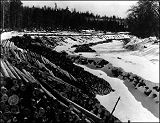| While nineteenth-century farmers were establishing agriculture in southern and western Minnesota, loggers were cutting most of the white, red, and jack pines growing on well-drained soils, and many spruce and fir trees that flourished in swamps and bogs. Clearing of the massive conifer forests continued into the first decades of the twentieth century. Production peaked in 1905. The lumber sawed in the state that year would have filled about 240,000 freight cars. New technology in the forests and at sawmills hastened the clearing of timber; and railroad expansion aided in the transport of timber that was too remotely located to be moved by water. [MIACOC] |
|
|
Lumberjacks

Engraving of early lumber mills at Little Falls, Minnesota.
The Northwest Magazine was typical of publications of its time.
Its prime purpose was to “sell” the idea that emigration
to the Minnesota outlands was a good idea.
Engraving from The Northwest Magazine, October 1891

Stacks of logs along a river awaiting spring thaw, 1937
MN Tourist Bureau and Minnesota Historical Society
|





